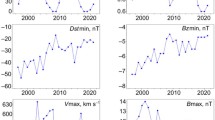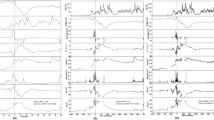Abstract
In order to predict space weather effects, solar flares are often used as precursors of magnetic storms on the Earth. In particular, possible relation between the solar flare importance and magnetic storm intensity is discussed in some papers. However, published results contradict each other. We compare the published results on the flare-storm dependence and discuss possible causes of this disagreement: (1) different intervals of observation, (2) differing statistics, and (3) different methods of identification of events and their comparison. Our analysis has shown that the fact of occurrence and the magnitude of a geomagnetic storm cannot be determined, generally, using only the solar flare importance. However, analyzing additional information on the coronal mass ejection (CME), associated with the geomagnetic storm, one can offer an algorithm for the storm magnitude prediction on the basis of flare importance.
Similar content being viewed by others
References
Burton, R.K., McPherron, R.L., and Russell, C.T., An Empirical Relationship between Interplanetary Conditions and D st, J. Geophys. Res., 1975, vol. 80, pp. 4204–4214.
Gonzalez, W.D., Joselyn, J.A., Kamide, Y., et al., What Is a Geomagnetic Storm?, J. Geophys. Res., 1994, vol. 99, pp. 5771–5792.
Yermolaev, Yu.I. and Yermolaev, M.Yu., Statistic Study on the Geomagnetic Storm Effectiveness of Solar and Interplanetary Events, J. Adv. Space Res., 2006, vol. 37, no. 6, pp. 1175–1181.
Zhang, J., Richardson, I.G., Webb, D.F., et al., Solar and Interplanetary Sources of Major Geomagnetic Storms (D st < −100 nT) during 1996–2005, J. Geophys. Res., 2007, vol. 112, A10102. doi: 10.1029/2007JA012321
Yermolaev, Yu.I., Yermolaev, M.Yu., Lodkina, I.G., and Nikolaeva, N.S., Statistical Investigation of Heliospheric Conditions Resulting in Magnetic Storms, Kosm. Issled., 2007, vol. 45, no. 1, pp. 3–11. [Cosmic Research, pp. 1–8].
Echer, E., Gonzalez, W.D., Tsurutani, B.T., and Gonzalez, A.L.C., Interplanetary Conditions Causing Intense Geomagnetic Storms (D st < −100 nT) during Solar Cycle 23 (1996–2006), J. Geophys. Res., 2008, vol. 113, A05221. doi: 10.1029/2007JA012744
Yermolaev, Yu.I., Nikolaeva, N.S., Lodkina, I.G., and Yermolaev, M.Yu., Relative Frequaency of Occurrence and Geoeffectiveness of Large-Scale Types of the Solar Wind, Kosm. Issled., 2009. vol. 47, no. 2, pp. 99–113 (Cosmic Research, pp. 81–94).
Miroshnichenko, L.I., Solar-Terrestrial Links, in Fizika kosmosa: malen’kaya entsiklopediya (Physics of Cosmos: A Small Encyclopedia), Syunyaev. R.A, Ed., Moscow: Sov. Entsiklopediya, 1986.
Gosling, J.T., Solar Flare Myth, J. Geophys. Res., 1993, vol. 98, p. 18937.
Harrison, R.A., Coronal Magnetic Storms: A New Perspective on Flares and the “Solar Flare Myth” Debate, Solar Phys., 1996, vol. 166, p. 441.
Cliver, E.W. and Hudson, H.S., CMEs: How Do the Puzzle Pieces Fit Together?, J. Atmos. Sol.-Terr. Phys., 2002, vol. 64, p. 231.
Harrison, R.A. and Bewsher, D., A Benchmark Event Sequence for Mass Ejection Onset Studies. A Flare Associated CME with Coronal Dimming, Ascending Pre-Flare Loops and a Transient Cool Loop, Astron. Astrophys., 2007, vol. 461, pp. 1155–1162.
Park, Y.D., Moon, Y.-J., et al., Delay Times between Geoeffective Solar Disturbances and Geomagnetic Indices, Astrophys. Space Science, 2002, vol. 279, pp. 343–354.
Ivanov, V.G. and Miletsky, E.V., Space and Time Factors of Solar Flare Geoeffectiveness, Proc. of the Climatic and Ecological Aspects of Solar Activity, Russia, St. Petersburg, 2003, p. 183.
Smith, Z.K., Murtagh, W., and Smithtro, C., Relationship between Solar Wind Low-Energy Energetic Ion Enhancements and Large Geomagnetic Storms, J. Geophys. Res., 2004, vol. 109, A01110 doi: 10.1029/2003JA010044.
Yermolaev, Yu.I., Yermolaev, M.Yu., Zastenker, G.N., et al., Statistical Studies of Geomagnetic Storm Dependencies on Solar and Interplanetary Events: A Review, Planet. Space Sci., 2005, vol. 53, nos. 1–3, pp. 189–196.
Daglis, I.A., Tsurutani, B.T., Gonzalez, W.D., Kozyra, J.U., et al., Key Features of Intense Geospace Storms — A Comparative Study of a Solar Maximum and a Solar Minimum Storm, Planet. Space Sci., 2007, vol. 55, pp. 32–52.
Yermolaev, Yu.I. and Yermolaev, M.Yu., Statistical Relationships between Solar, Interplanetary, and Geomagnetospheric Disturbances, 1976–2000, Kosm. Issled., 2002, vol. 40, no. 1, pp. 3–16. [Cosmic Research, pp. 1–14].
Yermolaev, Yu.I., Comment on “Geoeffestiveness of Halo Coronal Mass Ejestions” by N. Goralswamy, S. Yashiro, and S. Akiyama (J. Geophys. Res., 112, A06112, doi: 10.1029/2006JA012149),” Kosm. Issled., 2008, vol. 46, no. 6, pp. 572–573. [Cosmic Research, pp. 540–541].
Shrivastava, P.K. and Singh, G.N., Influence of Coronal Mass Ejection on Geomagnetic Activity during 1988–1993, Earth, Moon and Planets, 2002, vol. 91, pp. 1–8.
Yermolaev, Yu.I. and Yermolaev, M.Yu., Statistical Relations between Solar, Interplanetary, and Geomagnetic Disturbances during 2.3 Solar Cycles (1976–2000), Proc. of the Second Solar Cycle and Space Weather Euroconference, 24-29 September 2001, Vico Equense, Italy, Huguette Sawaya-Lacoste, Ed., SP-477, Noordwijk: ESA Publications Division, ISBN 92-9092-749-6, 2002, pp. 570–582.
Yermolaev, Yu.I. and Yermolaev, M.Yu., Statistical Relationships between Solar, Interplanetary, and Geomagnetospheric Disturbances, 1976–2000: 2, Kosm. Issled., 2003, vol. 41, no. 2, pp. 115–119. [Cosmic Research, pp. 105–109].
Yu. I. Yermolaev and M. Yu. Yermolaev, Statistical Relationships between Solar, Interplanetary, and Geomagnetospheric Disturbances, 1976–2000: 3, Kosm. Issled., 2003, vol. 41, no. 6, pp. 573–584. [Cosmic Research, pp. 539–549].
Yadav, M.P. and Kumar, S., Solar and Interplanetary Disturbances Causing Moderate Geomagnetic Storms, Proc. 28th Intern. Cosmic Ray Conf., 2003, pp. 3655–3659.
Kumar, S. and Yadav, M.P., Geoeffectiveness of Solar Features, Proc. 28th Intern. Cosmic Ray Conf., 2003, pp. 3665–3669.
Howard, T.A. and Tappin, S.J., Statistical Survey of Earthbound Interplanetary Shocks, Associated Coronal Mass Ejections and Their Space Weather Consequences, Astron. Astrophys., 2005, vol. 440, no. 1, p. 373.
Krajcovic, S. and Krivsky, L., Severe Geomagnetic Storms and Their Sources on the Sun, Astronomical Institutes of Czechoslovakia, Bulletin, 1982, vol. 33, no. 1, pp. 47–59.
Lindsay, G.M., Russell, C.T., and Luhmann, J.G., Coronal Mass Ejection and Stream Interaction Region Characteristics and Their Potential Geomagnetic Effectiveness, J. Geophys. Res., 1995, vol. 100, pp. 16999–17013.
Kahler, S.W., Sheeley, N.R.,Jr., Howard, R.A., et al., Coronal Mass Ejections and Associated X-Ray Flare Durations, Astrophys. J., 1989, vol. 344, p. 1026.
Yashiro, S., Gopalswamy, N., Akiyama, S., et al., Visibility of Coronal Mass Ejections as a Function of Flare Location and Intensity, J. Geophys. Res., 2005, vol. 110, A12S05. doi: 10.1029/2005JA011151.
Song, H., Yurchyshyn, V., Yang, G., et al., The Automatic Predictability of Super Geomagnetic Storms from Halo CMEs Associated with Large Solar Flares, Solar Physics, 2006, vol. 238, pp. 141–165.
Valach, F., Hejda, P., and Bochnicek, J., Geoeffectiveness of XRA Events Associated with RSP II and/or RSP IV Estimated Using the Artificial Neural Network, Studia Geophysica et Geodaetica, 2007, vol. 51, no. 4, pp. 551–562. doi: 10.1007/s11200-007-0032-5.
Prokudina, V.S., Kuril’chik, V.N., Yermolaev, Yu.I., et al., Peculiarities of Long-Wave Radio Bursts from Solar Flares Preceding Strong Geomagnetic Storms, Kosm. Issled., 2009, vol. 47, no. 1, pp. 17–24. [Cosmic Research, pp. 14–21].
Author information
Authors and Affiliations
Corresponding author
Additional information
Original Russian Text © Yu.I. Yermolaev, M.Yu. Yermolaev, 2009, published in Kosmicheskie Issledovaniya, 2009, Vol. 47, No. 6, pp. 495–500.
Rights and permissions
About this article
Cite this article
Yermolaev, Y.I., Yermolaev, M.Y. Does geomagnetic storm magnitude depend on solar flare importance?. Cosmic Res 47, 460–465 (2009). https://doi.org/10.1134/S0010952509060021
Received:
Published:
Issue Date:
DOI: https://doi.org/10.1134/S0010952509060021




